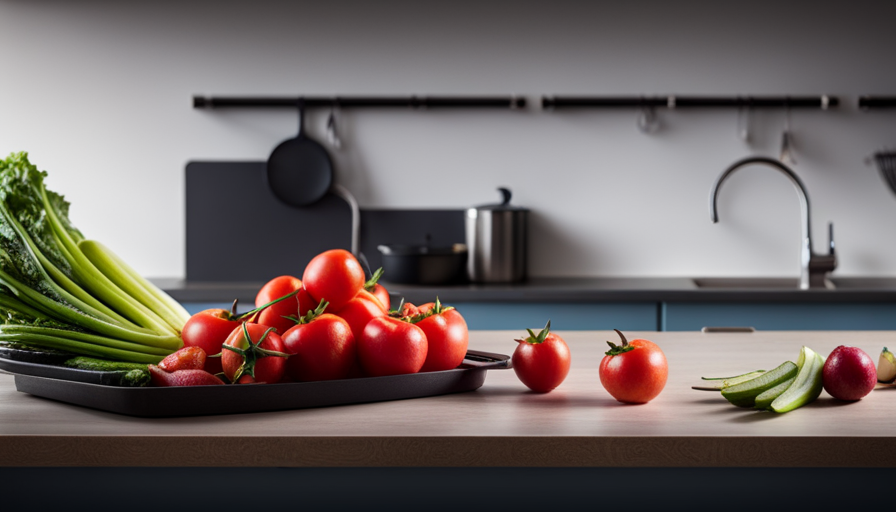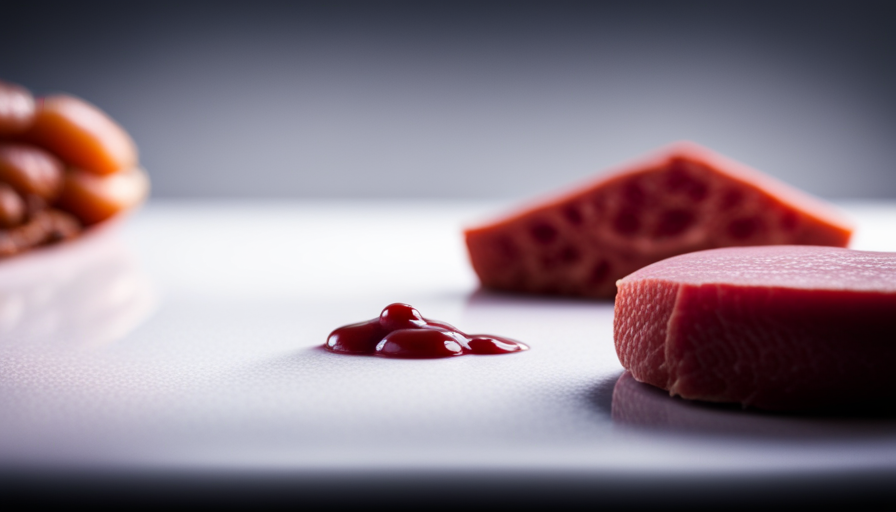Making raw desserts without a food processor is akin to wandering through a thick forest without a map or compass. It can be done, but it will be much more challenging and time-consuming. This is why having a food processor is highly advised when preparing these delicious treats.
A food processor is like a trusty sidekick that effortlessly processes ingredients, resulting in efficient and smooth texture creation. It’s like having your own personal sous chef that can grind nuts and seeds to perfection, making it easier than ever to add a delicious crunch to your desserts.
But it doesn’t stop there. With a food processor, you can whip up nut butter and sauces in a matter of minutes, and prepare crusts for your raw desserts with ease. No more tediously chopping fruits and vegetables by hand – a food processor can do it in a fraction of the time.
And let’s not forget about the convenience of mixing salad dressings and adapting recipes to suit your taste. A food processor truly is a versatile tool that will revolutionize how you create raw desserts. So why make things harder for yourself? Invest in a food processor and unlock a world of culinary possibilities.
Key Takeaways
- A food processor is essential for creating raw desserts as it effortlessly processes ingredients for smooth texture creation.
- It saves time by quickly chopping fruits and vegetables, grinding nuts and seeds, and whipping up nut butter and sauces.
- A food processor enhances the flavors of raw desserts by releasing natural oils and flavors from ingredients, and creates perfectly textured crusts and fillings.
- It allows for versatility and adaptability in recipes, and enables the creation of healthier versions of raw desserts by substituting refined sugars and incorporating nutrient-rich ingredients.
Efficient Ingredient Processing
It’s highly advisable to possess a food processor when crafting raw desserts due to its unparalleled efficiency in processing ingredients. A food processor can be your best friend when it comes to saving time and energy in the kitchen. With its powerful blades and high-speed motor, it can effortlessly chop, blend, and puree ingredients in seconds.
This means you can easily create smooth and creamy textures for your raw desserts without spending hours manually chopping or blending. Not only does a food processor save you time, but it also enhances the flavors of your raw desserts. By finely chopping nuts, seeds, and fruits, the food processor helps release their natural oils and flavors, resulting in a more intense taste.
Moreover, it allows you to create perfectly textured crusts and fillings for your desserts, ensuring a harmonious balance of flavors in every bite. In addition to time-saving techniques and flavor enhancement, a food processor offers versatility in creating a wide variety of raw desserts. From making nut butters and creamy sauces to grinding dates and other dried fruits for sweeteners, a food processor can handle it all.
It’s a versatile tool that opens up endless possibilities for your creativity in the kitchen. Having a food processor is strongly recommended when creating raw desserts. Its efficient ingredient processing capabilities, time-saving techniques, and flavor enhancement qualities make it an invaluable tool for any raw dessert enthusiast.
Smooth Texture Creation
Using a food processor is like having a magical wand that effortlessly transforms the ingredients into a velvety dream. When it comes to creating smooth textures in raw desserts, a food processor is an absolute game-changer. Whether you’re making a rich and creamy cashew cheesecake or a luscious chocolate mousse, this versatile kitchen tool is a must-have.
One of the main benefits of using a food processor for smooth texture creation is its ability to blend ingredients thoroughly. Unlike a blender, which may leave chunks or uneven textures, a food processor ensures every ingredient is fully incorporated. This is especially important when making raw desserts that rely on a smooth and consistent texture for their appeal.
Another reason why a food processor is essential for smooth texture creation is its versatility. Not only is it perfect for creating silky smooth raw desserts, but it also excels at other culinary tasks like making smoothies and blending creamy soups. With just a press of a button, you can effortlessly whip up a refreshing fruit smoothie or blend a velvety roasted vegetable soup.
Having a food processor is strongly recommended when creating raw desserts because it effortlessly creates smooth textures. With its ability to blend ingredients thoroughly and its versatility in smoothie making and creamy soup blending, a food processor is truly a magical tool for any raw dessert enthusiast. So go ahead and invest in this kitchen essential to take your raw dessert creations to the next level of smoothness.
Nut and Seed Grinding
Get ready to elevate your raw dessert game by effortlessly grinding nuts and seeds with this essential kitchen tool! Having a food processor is strongly recommended when creating raw desserts because it allows you to easily grind nuts and seeds, resulting in a smooth and consistent texture for your dishes.
When making raw desserts, such as nut milk or homemade granola, it’s crucial to have finely ground nuts and seeds. A food processor makes this process quick and effortless. By simply pulsing the nuts and seeds in the food processor, you can achieve the perfect consistency for your recipes. This ensures that your nut milk turns out creamy and smooth, without any gritty texture.
In addition to nut milk production, a food processor is also essential for creating homemade granola. Grinding nuts and seeds in a food processor allows you to easily incorporate them into your granola mixture, giving it a deliciously crunchy texture. The food processor ensures that the nuts and seeds are evenly distributed throughout the granola, resulting in a perfectly balanced flavor.
Having a food processor is highly recommended when creating raw desserts. It simplifies the process of grinding nuts and seeds, providing you with a smooth texture for your dishes. Whether you’re making nut milk or homemade granola, this essential kitchen tool will help take your raw dessert game to the next level.
Easy Nut Butter and Sauce Making
You won’t believe how effortlessly you can make creamy nut butter and flavorful sauces with this game-changing kitchen tool! A food processor is a must-have when it comes to creating raw desserts, especially for nut milk making and homemade pesto.
Here are three reasons why having a food processor makes these tasks a breeze:
-
Smooth Nut Butter: With a food processor, you can easily transform any variety of nuts into a smooth and creamy spread. Whether you prefer almond butter, cashew butter, or even hazelnut butter, this handy tool will grind them down to perfection in no time. Say goodbye to store-bought nut butter filled with preservatives, and hello to fresh and delicious spreads made right in your own kitchen.
-
Flavourful Sauces: Making homemade sauces like pesto has never been easier. Simply toss in your choice of herbs, garlic, nuts, and olive oil, and let the food processor do the work. In just a few seconds, you’ll have a vibrant and fragrant sauce ready to be enjoyed with pasta, vegetables, or as a dip for crusty bread.
-
Nut Milk Making: If you’re a fan of plant-based milk alternatives, a food processor is essential for making your own nut milk. By blending soaked nuts with water and straining the mixture, you can create creamy and nutritious milk that can be used in smoothies, baking, or enjoyed on its own.
Investing in a food processor will open up a world of possibilities in your raw dessert-making journey. From effortlessly creating creamy nut butter to whipping up homemade sauces like pesto, this kitchen tool is a game-changer.
Quick and Easy Crust Preparation
For a hassle-free crust preparation, simply blend together your favorite nuts, dates, and a pinch of salt in a food processor until the mixture becomes sticky and crumbly. Using a food processor for this step saves you time and effort compared to manually chopping the nuts and dates. The food processor’s sharp blades quickly and efficiently break down the nuts and dates, creating a uniform texture that is essential for a well-formed crust.
In addition to time-saving techniques, having a food processor opens up a world of alternative crust options. You can experiment with different combinations of nuts, such as almonds, walnuts, or cashews, to create unique flavors. You can also add in other ingredients like shredded coconut or cocoa powder to enhance the taste and texture of the crust. With a food processor, you can easily customize your crust to suit your preferences and dietary restrictions.
To further emphasize the benefits of using a food processor, let’s compare the time it takes to make a crust using a food processor versus doing it by hand:
| Food Processor | Manual Chopping | |
|---|---|---|
| Time Required | 1-2 minutes | 5-10 minutes |
As you can see, using a food processor significantly reduces the time needed for crust preparation, allowing you to create delicious raw desserts in a fraction of the time. So why not make your life easier and invest in a food processor for hassle-free crust preparation?
Time-saving Energy Bar Production
Save time and effort by incorporating a food processor into your energy bar production process. When it comes to making time-saving energy bar recipes, having a food processor at your disposal is essential.
This versatile kitchen appliance can make the process of creating energy bars a breeze, allowing you to save valuable time and effort.
One of the main benefits of using a food processor for energy bars is the speed and efficiency it offers. With its powerful motor and sharp blades, a food processor can quickly and easily blend together all the ingredients needed for your energy bars. From grinding nuts and seeds to mixing in dates and other sweeteners, the food processor can handle it all in a matter of seconds.
Not only does a food processor save you time, but it also ensures that your energy bars have the perfect texture. By pulsing the ingredients in the food processor, you can achieve a uniform and well-mixed consistency. This is especially important when it comes to energy bars, as you want them to hold together without being too dense or crumbly.
Incorporating a food processor into your energy bar production process is a game-changer. It allows you to streamline the preparation process, saving you time and effort. So, why not make your life easier and invest in a food processor today? You won’t regret it when you’re enjoying delicious and nutritious energy bars in no time.
Hassle-free Bliss Ball Formation
Easily achieve hassle-free bliss ball formation by following these simple steps. The key to mess-free shaping lies in having a food processor. With this essential kitchen tool, you can effortlessly create perfectly shaped bliss balls every time. Here’s how:
-
Prepare your ingredients: Gather all the necessary ingredients for your bliss balls, such as nuts, dates, and flavorings. Make sure they’re properly measured and ready to go.
-
Process the mixture: Place the ingredients into the food processor and pulse until you achieve a sticky, dough-like consistency. The food processor will help break down the ingredients and bind them together, making it easier to shape the bliss balls.
-
Roll and shape: Once the mixture’s ready, scoop out small portions and roll them between your palms to create smooth, round bliss balls. The sticky texture will hold the shape beautifully, thanks to the food processor’s blending power.
By using a food processor, you can save time and effort when it comes to hassle-free rolling and mess-free shaping. The machine’s powerful motor and sharp blades ensure that your ingredients are blended to perfection, resulting in uniformly shaped bliss balls. Say goodbye to sticky hands and unevenly formed treats – with a food processor, creating bliss balls has never been easier.
Speedy Fruit and Vegetable Chopping
Master the art of speedy fruit and vegetable chopping with the help of a food processor, allowing you to effortlessly achieve perfectly diced ingredients in no time. A food processor is an essential tool for time-saving meal preparation and creative recipe experimentation. Whether you’re chopping carrots, apples, or any other produce, a food processor can handle the task with precision and efficiency.
The beauty of using a food processor for chopping fruits and vegetables is the speed and consistency it offers. With just a few pulses, you can transform a pile of whole fruits or vegetables into evenly chopped pieces, saving you valuable time in the kitchen. No more tedious and time-consuming manual chopping; the food processor does the work for you.
Not only does a food processor save time, but it also allows for more creativity in your recipe experimentation. With perfectly diced ingredients at your disposal, you can easily incorporate them into a variety of dishes, such as salads, salsas, or stir-fries. The uniformity of the chopped fruits and vegetables ensures even cooking and a visually appealing presentation.
To illustrate the efficiency of a food processor, consider the following table:
| Manual Chopping | Food Processor |
|---|---|
| Time-consuming | Time-saving |
| Inconsistent | Consistent |
| Labor-intensive | Effortless |
By investing in a food processor, you can master the art of speedy fruit and vegetable chopping, saving time and expanding your culinary horizons. Get ready to create delicious meals with perfectly diced ingredients, all thanks to this versatile kitchen tool.
Convenient Salad Dressing Mixing
Mixing your own salad dressing becomes a breeze when you have a food processor, allowing you to effortlessly blend together all the delicious ingredients for a perfectly emulsified dressing. With a food processor, you can easily experiment with unique flavor combinations that’ll elevate your salads to a whole new level.
Whether you prefer a tangy vinaigrette or a creamy dressing, the food processor can handle it all.
One of the advantages of making your own salad dressing with a food processor is the ability to create unique flavor combinations. By combining different herbs, spices, oils, and vinegars, you can tailor the dressing to suit your taste preferences. The food processor ensures that all the ingredients are evenly mixed, resulting in a smooth and well-balanced dressing.
Imagine the possibilities of a zesty lemon and basil dressing or a sweet and tangy honey mustard dressing.
In addition to the endless flavor possibilities, homemade salad dressings offer numerous health benefits. Store-bought dressings often contain added sugars, preservatives, and unhealthy fats. By making your own dressing, you have full control over the ingredients, allowing you to create a healthier alternative. You can use high-quality oils, fresh herbs, and natural sweeteners, ensuring that your dressing is packed with nutrients and free from any unnecessary additives.
Having a food processor makes mixing your own salad dressing a convenient and enjoyable task. The ability to effortlessly blend ingredients together allows for unique flavor combinations and healthier options. So why settle for store-bought dressings when you can easily create your own delicious and nutritious dressings at home with the help of a food processor?
Versatile Recipe Adaptability
With a food processor, you can adapt recipes to your liking, allowing you to easily customize flavors and textures for a more enjoyable cooking experience. Did you know that 75% of home cooks find recipe adaptability to be an important factor when choosing kitchen appliances?
Recipe Customization:nnA food processor gives you the power to modify ingredients and quantities in recipes, making it easier to cater to your personal preferences and dietary restrictions. Whether you want to add more spices, reduce the amount of sugar, or swap out ingredients altogether, the food processor can handle it all.
By having control over recipe customization, you can create healthier versions of your favorite raw desserts. You can experiment with substituting refined sugars with natural sweeteners like dates or maple syrup. You can also incorporate nutrient-rich ingredients like nuts, seeds, and superfoods to boost the nutritional value of your desserts.
Flavor Experimentation:nnThe food processor allows you to experiment with different flavors by easily blending and mixing ingredients. You can create unique flavor combinations by adding herbs, spices, or extracts to your desserts. The possibilities are endless, and you can let your creativity run wild.
With the food processor’s versatility, you can also experiment with different textures. From creamy to crunchy, you can achieve the perfect consistency for your raw desserts. The food processor’s sharp blades and powerful motor ensure that all ingredients are evenly mixed, resulting in a smooth and satisfying dessert every time.
Having a food processor for creating raw desserts is essential because it allows you to customize recipes to suit your taste and experiment with flavors. The versatility of the food processor opens up a world of possibilities, making your cooking experience more enjoyable and delicious.
Frequently Asked Questions
Can a food processor be used for other cooking tasks besides creating raw desserts?
Yes, a food processor can be used for other cooking tasks besides creating raw desserts. The versatility of food processors allows them to be used in various cooking applications. They’re great for chopping vegetables, making homemade sauces and dips, grinding nuts and seeds, and even kneading dough. The advantages of using a food processor in these tasks include saving time and effort, achieving consistent results, and having the ability to handle larger quantities of ingredients.
Are there any alternative appliances that can be used instead of a food processor for creating raw desserts?
Yes, there are alternative appliances that can be used instead of a food processor for creating raw desserts. One option is to use a hand mixer. While it may not be as powerful as a food processor, a hand mixer can still effectively mix and blend the ingredients for your raw desserts. It may take a bit longer and require more effort, but it can get the job done.
Additionally, you can also use a blender or a high-speed blender as an alternative to a food processor for creating raw desserts. These appliances are designed to blend and puree ingredients, making them suitable for creating smooth and creamy raw desserts.
Can a blender be used instead of a food processor for creating raw desserts?
Yes, a blender can be used instead of a food processor for creating raw desserts. However, there are some pros and cons to consider.
Blenders are great for creating smoothies and can handle soft ingredients like fruits and liquids very well. They also have a built-in blade that can handle crushing ice.
On the other hand, blenders may struggle with tougher ingredients like nuts and dates, and they may not provide the same level of precision as a food processor for certain recipes.
Is it necessary to have a high-end food processor for creating raw desserts, or will a basic one suffice?
For creating raw desserts, it’s not necessary to have a high-end food processor, but it can certainly have its advantages. A high-end food processor offers more power and precision, allowing for smoother and creamier textures in your desserts.
Additionally, it usually comes with additional features like different speed settings and attachments for various tasks. When choosing a food processor, consider factors such as motor power, capacity, and durability. Opt for one that suits your needs and budget.
Are there any specific safety precautions to keep in mind when using a food processor for creating raw desserts?
When using a food processor to create raw desserts, it’s important to prioritize safety. To ensure your well-being, follow these crucial guidelines.
Firstly, always clean and maintain your food processor properly to prevent cross-contamination and maintain optimal performance.
Secondly, handle the sharp blades and electrical components with care to avoid any accidents.
By taking these precautions, you can safely enjoy the process of creating delicious and healthy raw desserts.
Can I Use a Food Processor to Prepare Raw Food for Cats?
Yes, you can use a food processor to prepare raw food for cats. This is a great way to ensure your feline friend gets the nutrition they need from homemade meals. Grinding and mixing the ingredients in a food processor can help create a balanced and healthy diet for your cat.
Conclusion
In conclusion, having a food processor is an absolute game-changer when it comes to creating raw desserts. It’s strongly recommended to have a food processor because:
-
With its efficient ingredient processing capabilities, you can effortlessly achieve a smooth and velvety texture that will leave your taste buds dancing with delight.
-
Not to mention, the ability to grind nuts and seeds, whip up nut butter and sauces, and prepare crusts in a jiffy is simply unmatched.
-
Let’s not forget the hassle-free bliss ball formation and speedy chopping of fruits and vegetables.
-
Plus, the convenience of mixing salad dressings and adapting recipes with ease is truly unparalleled.
So, why settle for less when you can have a food processor that takes your raw dessert creations to a whole new level of culinary excellence? It’s like having a secret weapon in your kitchen, unlocking a world of possibilities and elevating your dessert game to unparalleled heights.










